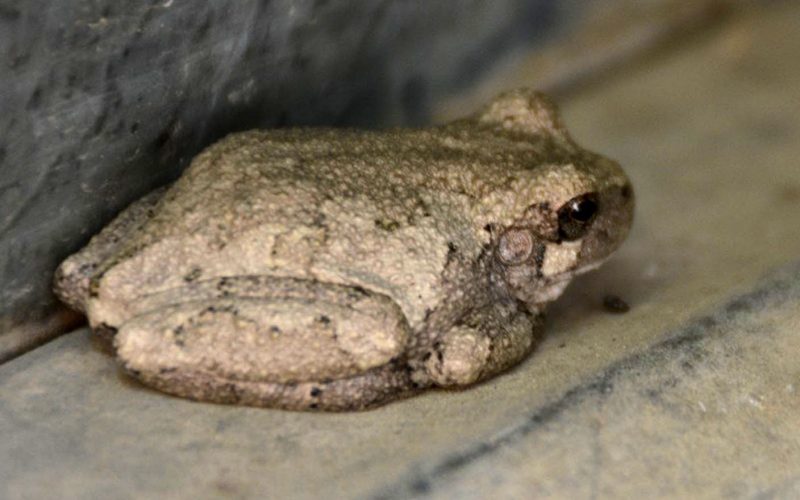Tiny amphibians can live up to 10 years
AMANDA BANCROFT
Making Ripples
That rock just blinked! Or maybe it was a piece of tree bark or a patch of porch paint.
The eyes belong to gray tree frogs, which are tiny and can be difficult to detect. They are nomads of the night, coming together only to breed. They’re sometimes kept as pets and are docile when handled, although our skin isn’t good for their skin. They can pop up in toilets, appear randomly in mailboxes and climb vertical walls to keep the porch light company while they hunt for insects attracted to the glow. In short, they’re adorable little balls of amphibian.
Gray tree frogs have an easy to remember scientific name, Hyla versicolor, which sounds similar to “highly versicolor” or many colors. Unlike chameleons, which change color based on their mood, these frogs can camouflage themselves to their environment in about 30 minutes. According to the Smithsonian National Zoo, factors like temperature and time of day affect color, too: The frogs are lighter at night and darker during daylight. The colors range from white to gray, light or dark green, brown and black, often with a mottled look that resembles moss or lichen (this appears three-dimensional due to their warty skin). They have a white spot beneath each eye and bright yellow or yellow-orange patches on their inner hind legs, which they flash while jumping. Males typically have darker throats than females. Tadpoles can have reddish tails if there are predators in the water. Froglets are almost always green for their first few days, changing to the common gray later. Young frogs might remain light green until changing to a darker green in adulthood, but if they’re on manmade structures, the frogs are usually gray, while among tree leaves they’re usually green.
These frogs prefer breeding in watery, forested areas without fish, but they aren’t picky. A puddle, vernal pool, swamp, backyard fountain or swimming pool cover full of rainwater will do just fine. If you regularly find frogs in your pool that can’t get out, consider installing a Frog Log Critter Saving Escape Ramp which you can find online at Amazon. Females produce 1,000 to 2,000 externally fertilized eggs during mating. They can mate up to three times per breeding season, which lasts from spring through August (although most eggs are laid in spring). As tadpoles, they eat algae and can develop into frogs within two months.
Their survival strategies are quite amazing! Tree frogs have marvelously adaptive webbed feet with toe tips that resemble tiny suction cups. These tips secrete an adhesive fluid that allows the frog to climb. To survive winter, they shelter in trees and freeze while maintaining a slow metabolism. They produce glycerol to protect their cells from damage by ice crystals while frozen. Adult tree frogs may prey upon their own larvae to survive. They also eat crickets, insects, snails, slugs, spiders, and even smaller frogs. Surprisingly, gray tree frogs can live almost 10 years!
Amanda Bancroft is a writer, artist, and naturalist building an off-grid cottage for land conservation on Mt. Kessler. She and her husband Ryan blog about their adventures and offer a solar-hosted online educational center on how to make a difference with everyday choices at www.RipplesBlog.org.











